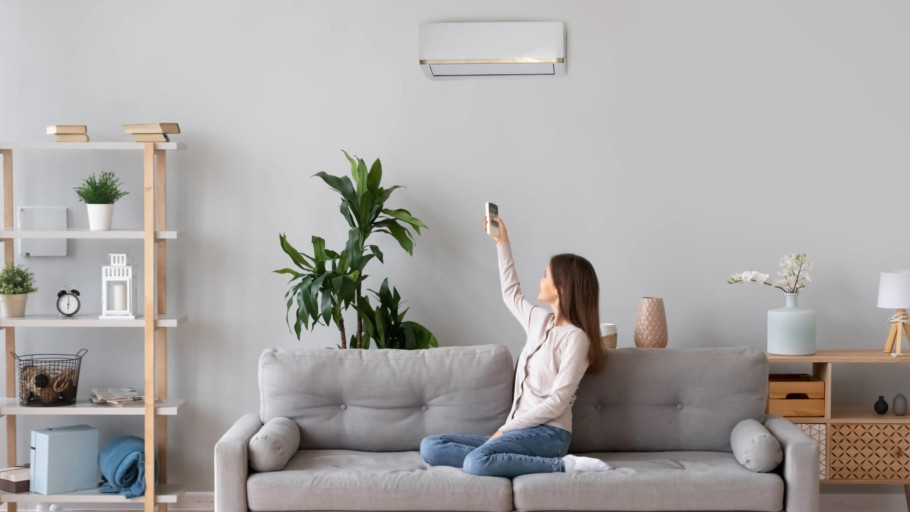The Best Whole House Air Purifiers
It’s no secret that air purifiers provide health benefits, and of the best ways to protect your home from air pollutants is to invest in a good quality whole house air purifier.
Unlike room air purifiers which are designed to cover individual spaces, whole house air purifiers are connected to your existing heating, ventilation, and air conditioning (HVAC) systems. They provide additional protection from air pollutants for your entire home 24 hours a day, in areas up to thousands of square feet in size. Furthermore, the added filters from a whole house air purifier makes your HVAC system much more efficient at blocking out air pollutants.
For those who suffer from allergies, asthma, or other respiratory diseases, and who want to learn more about how whole house air purifiers and how they can improve your quality of life, keep reading. In this article, we take a look at the best whole house air purifiers on the market today.
- Low maintenance (no filters)
- 3,000 sq. ft. coverage
- ActivePure technology
- Remove 99% of contaminants
- Doesn’t produce ozone
- 5-year warranty
- Four IQAir HyperHEPA filters
- 2000 cfm airflow rate
- MERV 16 Rated
- 20,000 sq. ft. coverage
- Energy efficient
- 10-year guarantee
- Affordable price
- MERV 16 Rated
- Traps 94% of respirable dust
- Event-Based control panel
- Low maintenance
- 2,500 sq. ft. coverage
- 3-stage filtration system
- Long-lasting HEPA filter
- 1000 cfm air flow rate
- Large 11,250 sq. ft coverage
- Great for odors, gases, and VOCs
- 5 year warranty

Beyond by Aerus is not the most popular air purifier brand, but their Sanctuairy whole house air purification system is definitely making waves with the latest technology in air purification: “ActivePure technology”. This technology involves photocatalytic oxidation (PCO), which uses UV light as a catalyst to clean the air. It is so advanced that it is certified as Space Technology and is being used by NASA on space missions.
The ActivePure technology from Sanctuairy is directly attached to your HVAC system to remove 99% of VOCs, surface contaminants, pet dander, odors, and dust across a 3,000 sq. ft coverage. Unlike other photocatalytic oxidation cleaners, the ActivePure technology does not produce ozone as a byproduct and it uses no filters whatsoever – which makes this purifier virtually maintenance-free.
On the downside, like most whole house air purifiers, the Sanctuairy needs to be installed by a professional so this will likely incur some additional costs aside from the upfront fee. Furthermore, the Sanctuairy doesn’t have a fixed air-exchange rate, since it depends on your HVAC system air handler.
Pros
- No filters to replace (low maintenance)
- Affordable
- 3000 sq.ft coverage
- Space Technology certified
- Removes 99% of contaminants
- Doesn’t produce ozone like other PCO cleaners
Cons
- Air-exchange rate depends on air handler of HVAC system
- Needs to be installed by a professional
The IQAir Perfect 16 Whole House Air Purifier comes in 2 variations: the Perfect 16 ID-2225 and Perfect 16 ID-2530, with the cheaper ID-2225 having a lower airflow rate of 1200 cfm and smaller dimensions.
However, the main selling point of the Perfect 16 system is that it makes use of four IQAir HyperHEPA filters, which is IQAir’s own brand of True HEPA filters. Both systems make use of these filters, arranged in a unique double V formation to ensure airflow is 50 times more powerful than ordinary filtration systems. With an impressive 2000 cfm airflow rate, the Perfect 16 ID-2530 is able to scrub extremely large amounts of air per minute.
In addition to being True HEPA filters, the American Society of Heating, Refrigerating and Air-Conditioning Engineers (ASHRAE) rated the model’s Minimum Efficiency Reporting Value (MERV) filter at 16, the highest possible rating that a filter can get. This means they’re able to remove at least 95% of particles 0.3 microns in size and at least 75% of particles 0.003 microns in size.
Offering 20,000 sq. ft. coverage, you can definitely count on this system to trap a range of pollutants such as pollen, dust mites, mold spores, bacteria, viruses, and pollution particles. In addition to this efficiency, the Perfect 16’s filters also last 3 years on average. This means you can enjoy longer periods of no maintenance. Furthermore, it’s highly energy efficient, since it’s non-motorized and relies on your existing HVAC to run.
Unfortunately, the Perfect 16 ID-2530 is very expensive and will cost you more than $3,000 to install. Luckily, the installation fee is covered by the upfront payment, but you’ll also need to consider the added cost of replacement filters. Overall, though, the Perfect 16 is a very high quality and high efficiency air purification system that will greatly benefit any household.
Pros
- High efficiency filters
- 2000 cfm airflow rate
- 20,000 sq. ft coverage
- Low maintenance
- Energy efficient
- 10-year warranty
- Large area coverage
Cons
- Expensive
- Needs to be installed by a professional

The Aprilaire 5000 Air Cleaner is the oldest air purifier in this list and was introduced back in 2006. However, it has stood the test of time and, even to this day, remains one of the most budget-friendly and effective whole house air purifiers. Admittedly, it does have a very dated design compared to the other air purifiers on this list, but this doesn’t affect its performance in the slightest.
With a 2,500 sq. ft. coverage and equipped with an Aprilaire 501 filter rated at MERV 16, the 5000 model is definitely one of the best at trapping even the smallest air pollutants. Tested independently in a laboratory, results showed that the 5000 model trapped 98% of bacteria, fungi, dust mites, and pollen; 95% of visible smoke and smog; 80% of particles as small as 0.01 micron in size, and 99% of particles 1 micron in size or larger.
A set of ionizing cables draw in air pollutants and trap them in the filter to make sure that no pollutants escape. In addition, it has an event-based control panel which tells you if it’s running, if the filters need changing, and allows you to manually turn the cleaner on or off. Overall, the 5000 model is very easy to use and maintain – and considering its very modest price tag, it’s definitely great value.
Unfortunately, like the Perfect 16, the 5000 model needs to be installed by a professional at additional cost. Its filters also need to be replaced more often compared to other whole house air purifiers, as they last a year at most. This will eventually add up to more expense in the long run.
Pros
- Affordable
- High-efficiency filter
- 2,500 sq. ft. coverage
- Traps very small pollutants
- Easy to use
- Low maintenance
- Energy efficient
Cons
- Old model
- Needs to be installed by a professional
- Filters need to be replaced yearly
The Amaircare 10000 is the most expensive whole house air purifier on this list at just under $4,000, but it’s also one of the most powerful against different types of air pollutants.
It features a more comprehensive 3-stage filtration system comprised of a pre-filter, HEPA filter, and carbon filter that can trap odors, gasses, and Volatile Organic Compounds (VOCs). It even comes with an optional VOC filter to increase its capacity to capture chemical and gas pollution. Impressively, the Amaircare 10000 is able to cover homes as large as 11,250 sq. ft. in size and has a variable speed switch so that you can control the airflow rate. Furthermore, the Amaircare 10000 has a decent standard airflow rate of 1000 cfm, and is incredibly easy to maintain.
Unfortunately, though, the frequency of filter-changes let this product down. The pre-filter and carbon filter have a relatively short lifespan. The pre-filter has to be replaced yearly and the carbon filter has to be replaced every 6 months. This means that the Amaircare is more high maintenance than some other whole house air purifiers. However, the more expensive HEPA filter only needs to be replaced every 3 to 5 years.
On a further note, the Amaircare 10000 is rated to consume about 600 watts of energy, which may be problematic for people who would rather avoid increased electricity costs. This is because it uses its own motor to run the entire system.
Pros
- Long-life HEPA filter
- Large 11,250 sq. ft. coverage
- Good for odors, gases, and VOCs
- Optional VOC filter
- 1000 cfm airflow rate
Cons
- Expensive
- Short life pre and carbon filter
- High energy consumption
- Needs to be installed by a professional
Comparison Chart
| FEATURES | IQAir Perfect 16 ID-2530 Whole House Air Purifier | Aprilaire 5000 Air Cleaner | Amaircare 10000 | Sanctuairy by Beyond by Aerus |
| Type | Whole house air purifier, in-duct | Whole house air purifier, in-duct | Whole house air purifier, in-duct | Whole house air purifier, in-duct |
| Size | 29.25 x 25.25 x 21.25 | 12 x 31 x 16 | 17.3 x 27.9 x 47.2 | 8.5 x 8.5 x 11 |
| Filters/ Technology | HEPA | Aprilaire 501 filter MERV 16 + Ionizing wires | Pre + HEPA + Carbon | Photocatalytic Oxidation |
| Coverage | 20,000 sq. ft. | 2,500 sq. ft. | 11,250 sq. ft. | 3,000 sq. ft. |
| Airflow | 2000 CFM | 2000 CFM | 1000 CFM | n/a |
Buyer’s Guide:
Whole House Air Purifiers
Final Thoughts
A lot of people may be intimidated by the amount of money and effort that goes into installing whole house air purifying systems: they never come cheap, they require you to determine how your existing HVAC system will be affected, and they almost always need to be installed by professionals. With the steady rise of pollution, however, we need to be taking extra precautions to keep our homes and our family safe.
After considering all the above options, our budget pick is no doubt the Aprilaire 5000. For a reasonable price , you’re getting a long-lasting, high quality air purifier that has a MERV 16 rated air filter and ionizing cables capable of removing all the common household air pollutants over a 2,500 sq. ft. space.
However, our overall winner for the best whole house air purifier for 2019 is the Sanctuairy by Beyond by Aerus. For a very reasonable price, you’re getting an air purifier that uses ActivePure Technology which is not only environmentally friendly, but also highly efficient at removing 99% of both surface and airborne contaminants as well as odors and VOCs.
If NASA trusts this technology for use in outer space, then you should trust it to purify the air in your home too.








